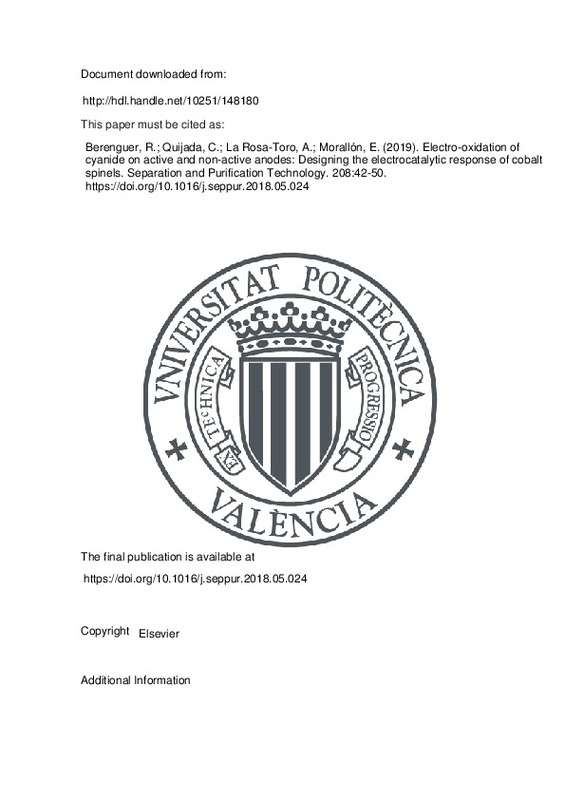JavaScript is disabled for your browser. Some features of this site may not work without it.
Buscar en RiuNet
Listar
Mi cuenta
Estadísticas
Ayuda RiuNet
Admin. UPV
Electro-oxidation of cyanide on active and non-active anodes: Designing the electrocatalytic response of cobalt spinels
Mostrar el registro sencillo del ítem
Ficheros en el ítem
| dc.contributor.author | Berenguer, R.
|
es_ES |
| dc.contributor.author | Quijada, César
|
es_ES |
| dc.contributor.author | La Rosa-Toro, A.
|
es_ES |
| dc.contributor.author | Morallón, E.
|
es_ES |
| dc.date.accessioned | 2020-07-17T03:31:54Z | |
| dc.date.available | 2020-07-17T03:31:54Z | |
| dc.date.issued | 2019-01-08 | es_ES |
| dc.identifier.issn | 1383-5866 | es_ES |
| dc.identifier.uri | http://hdl.handle.net/10251/148180 | |
| dc.description.abstract | [EN] The feasibility of the electrochemical technologies for wastewater treatment greatly relies on the design of efficient but inexpensive electrocatalysts. It is generally accepted that the so-called ¿non-active¿ anodes (like the boron-doped diamond (BDD) or SnO2-based anodes), producing highly oxidizing hydroxyl radicals, are the most promising candidates for pollutants abatement. In this work, the electrocatalytic performance of various cobalt oxides, pure and doped with Cu or Au, for CN¿ oxidation has been studied and compared with that of conventional graphite, BDD, SnO2-Sb and SnO2-Sb-Pt. The metal oxide electrodes were prepared by thermal decomposition of the salt precursors onto Ti. For the M-doped Co3O4 electrodes, the nominal M/Co ratios were Cu/ Co=0.07¿1.00; and Au/Co=0.05¿0.20. The electrodes were characterized by different techniques (XRD, SEM, EDX, XPS) and their electrocatalytic response was studied by cyclic voltammetry and galvanostatic electrolysis in a H-type cell in aqueous 0.1M NaOH. The obtained results show that the nature of the dopant plays a key role on the electrocatalytic behavior of cobalt spinels. Thus, while Cu catalyzes the CN¿ electro-oxidation, Au declines it. This is explained by the fact that, unlike Au (which segregates as Au-rich particles), Cu is effectively incorporated into the spinel structure by forming a solid solution (CuxCo3-xO4). In this solid solution, atomic scale Cu(spinel)-CN¿ specific interactions occur to catalyze the reaction, whereas in segregated Au particles the oxidation is hindered probably by a too-strong adsorption of cyanide and/or its inaccessibility to oxide active sites. Electrolysis runs have revealed that ¿active¿ over-saturated Cu-doped spinels (Cu/Co=1.00) exhibit higher current efficiencies than conventional graphite and ¿non-active¿ BDD and SnO2-based anodes. Hence, we hereby demonstrate that an inexpensive ¿active¿ electrocatalyst can show even higher efficiency than the most powerful BDD anode. These results highlight the significance of anode design in the application of the electrochemical technique for wastewater treatment. | es_ES |
| dc.description.sponsorship | Financial support from the Spanish Ministerio de Economia y Competitividad and FEDER funds (MAT2016-76595-R, IJCI-2014-20012) is gratefully acknowledged | es_ES |
| dc.language | Inglés | es_ES |
| dc.publisher | Elsevier | es_ES |
| dc.relation.ispartof | Separation and Purification Technology | es_ES |
| dc.rights | Reserva de todos los derechos | es_ES |
| dc.subject | Electrochemical oxidation | es_ES |
| dc.subject | Wastewater | es_ES |
| dc.subject | Cyanide | es_ES |
| dc.subject | Cobalt spinel | es_ES |
| dc.subject | Active anode | es_ES |
| dc.subject.classification | QUIMICA FISICA | es_ES |
| dc.title | Electro-oxidation of cyanide on active and non-active anodes: Designing the electrocatalytic response of cobalt spinels | es_ES |
| dc.type | Artículo | es_ES |
| dc.identifier.doi | 10.1016/j.seppur.2018.05.024 | es_ES |
| dc.relation.projectID | info:eu-repo/grantAgreement/MINECO//MAT2016-76595-R/ES/NUEVAS ESTRATEGIAS DE FUNCIONALIZACION ELECTROQUIMICA DE MATERIALES CARBONOSOS NANOESTRUCTURADOS PARA LA REDUCCION DE OXIGENO Y BIOSENSORES/ | es_ES |
| dc.relation.projectID | info:eu-repo/grantAgreement/MINECO//IJCI-2014-20013/ES/IJCI-2014-20013/ | es_ES |
| dc.rights.accessRights | Abierto | es_ES |
| dc.contributor.affiliation | Universitat Politècnica de València. Departamento de Ingeniería Textil y Papelera - Departament d'Enginyeria Tèxtil i Paperera | es_ES |
| dc.description.bibliographicCitation | Berenguer, R.; Quijada, C.; La Rosa-Toro, A.; Morallón, E. (2019). Electro-oxidation of cyanide on active and non-active anodes: Designing the electrocatalytic response of cobalt spinels. Separation and Purification Technology. 208:42-50. https://doi.org/10.1016/j.seppur.2018.05.024 | es_ES |
| dc.description.accrualMethod | S | es_ES |
| dc.relation.publisherversion | https://doi.org/10.1016/j.seppur.2018.05.024 | es_ES |
| dc.description.upvformatpinicio | 42 | es_ES |
| dc.description.upvformatpfin | 50 | es_ES |
| dc.type.version | info:eu-repo/semantics/publishedVersion | es_ES |
| dc.description.volume | 208 | es_ES |
| dc.relation.pasarela | S\370166 | es_ES |
| dc.contributor.funder | European Regional Development Fund | es_ES |
| dc.contributor.funder | Ministerio de Economía y Competitividad | es_ES |







![[Cerrado]](/themes/UPV/images/candado.png)

